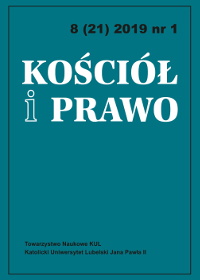Die Auswirkungen des Konkordats zwischen dem Apostolischen Stuhl und Polen von 1925 auf die Eparchie Stanislaviv
Abstrakt
Wpływ konkordatu między Stolicą Apostolską a Rzecząpospolitą Polską z 1925 r. na Eparchię Stanisławowską
Po upadku państw centralnych władze ukraińska i polska próbowały przywrócić własne państwo. Próby te były zasadniczo komplikowane przez sytuację etniczno-polityczną w Galicji, zwłaszcza po decyzji Ententy z 15 marca 1923 r. o połączeniu Galicji Wschodniej z Polską. Dla ukraińskiego Kościoła greckokatolickiego (UKGK) rozpoczęła się kolejna szansa i wyzwanie – współpraca z nowym rządem i rzeczywistością. Taka zmiana geopolityczna spowodowała pewnego rodzaju nihilizm prawny w stosunku do relacji państwa i kościoła, które okazało się selektywną sprawiedliwością. Te stosunki prawne powinien był rozstrzygać konkordat między Stolicą Apostolską a państwem polskim. Głównymi warunkami wstępnymi przygotowania konkordatu ze strony ukraińskiego Kościoła greckokatolickiego były niepewność prawna, napięte trudności finansowe i gospodarcze oraz kwestie społeczno-polityczne w społeczeństwie. Kościół obrządku bizantyjskiego w tym procesie przygotowawczym był prowadzony przez metropolitę Szeptyckiego, który przemawiał w imieniu swoich biskupów ze Stanisławowa i Przemyśla oraz ich wiernych. Ważne dla UKGK było wyjaśnienie kwestii własności kościelnej, wyborów biskupów, świadectwa chrztu, edukacji i struktur kościelnych. Umowa, podpisana 10 lutego 1925 r., zobowiązała do złożenia przysięgi wierności wszystkich biskupów UKGK, w tym biskupa Grzegorza Chomyszyna (1867-1945), prezydentowi polskiemu i zobowiązała do lojalności wobec państwa.
Bibliografia
Baran, Stepan. 1940. “Tserkovne pytannia w Polshchi.” https://zbruc.eu/node/353 74 [eingesehen am: 16.04.2019].
Baran, Stepan. 1947. Mytropolyt Andrei Sheptyts’kyi. Zhyttia i dijalnist. München: Vernyhora.
“Die Rolle der katholischen Kirche in der polnischen Geschichte seit 1795.” http:// www.puhli.de/uni/papers/kirche-in-polen/geschichte.html [eingesehen am: 17.04.2019].
Hentosh, Liliana. 2016a. “Rol’metropolyta Andreia Sheptyts’koho v ukladenni konkordatu mizh Apostolskym Prestolom i Polshcheju (1925).” Posen 10:115-28.
Hentosh, Liliana. 2016b. “Hreko-katolytskoji tserkvy u Polshchi do pidpysannja konkordatu 1925 r.” Eminak 1(3): 21-25.
Jehreshij, Oleh. 2003. Suspilno-politychna ta kulturalno-prosvitnycka dijalnist jepyskopa Hryhorija Chomyšyna (1904-1945 rr). Ivano-Frankivsk: Prykarpats’kyy natsional’nyy universytet imeni Vasylya Stefanyka.
Mroěz, Maciej. 2004. W kregu dyplomacji watykaněskiej. Rosja, Polska, Ukraina w dyplomacji Watykaněskiej w latach 1917-1926. Toruně: Wydawnictwo Adam Marszałek.
Perewesij, Vitaliy. 1998. Hreko-katolytska tserkvy v umovach ukrainsko-polskoi konfrontacii 20 roky XX st. Kiev: Natsional’na akademiya nauk Ukrayiny, Instytut politychnykh ta etnonatsional’nykh doslidzhen’.
Pylypiv, Ihor. 2013. “Pravovyj status hreko-katolytskoi tserkvy d druhij Rechi Pospolytij (1925-1939).” Efektyvnist derzhavnoho upravlinnia (Effektivität der staatlichen Verwaltung) 34:153-62.
Wolf, Hubert. 2010. Pope and Devil. The Vatican’s Archives and the Third Reich. Cambridge: The Belknap Press of Harvard University Press.
Copyright (c) 2019 Kościół i Prawo

Utwór dostępny jest na licencji Creative Commons Uznanie autorstwa – Użycie niekomercyjne – Bez utworów zależnych 4.0 Międzynarodowe.





